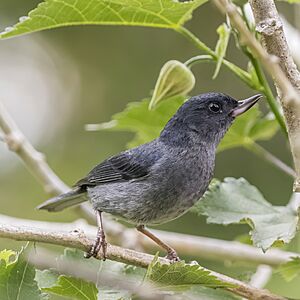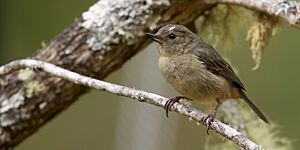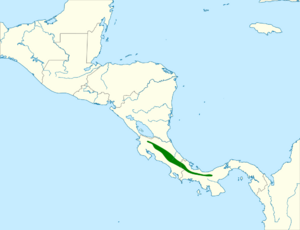Slaty flowerpiercer facts for kids
Quick facts for kids Slaty flowerpiercer |
|
|---|---|
 |
|
| Male, Panama | |
 |
|
| Female, Costa Rica | |
| Conservation status | |
| Scientific classification | |
| Genus: |
Diglossa
|
| Species: |
plumbea
|
 |
|
The slaty flowerpiercer (Diglossa plumbea) is a small passerine bird. It lives only in the Talamancan montane forests. These forests are found in the mountains of Costa Rica and Panama.
Where Does It Live?
This bird is common in mountain forests. It likes the tops of trees and forest edges. You can often see it in sunny clearings. It also enjoys areas with lots of flowering bushes. Sometimes, it even visits gardens!
The slaty flowerpiercer lives high up in the mountains. Its home starts at about 1200 meters (4,000 feet) above sea level. In some southern mountains, it lives even higher, up to 1900 meters (6,200 feet). It can also be found in very high, open grasslands called páramo.
What Does It Look Like?
The slaty flowerpiercer is a small bird. It is about 10 centimeters (4 inches) long. It weighs around 9 grams (0.3 ounces). It has a special bill. The top part is hooked and points up. The bottom part is pointed.
The adult male bird is blue-grey. Its throat and chest are a darker lead-grey color. Its tail and wings are blackish. They have grey edges on their feathers.
The female bird looks different. She is olive-brown on her back. Her throat and chest are lighter. Her belly is a buff (light yellowish-brown) color.
Young birds look like the female. But they have two tawny (orange-brown) bars on their wings. Their underparts are buff-yellow with faint streaks.
Sounds and Songs
The slaty flowerpiercer has a thin call. It sounds like tsip.
The male bird sings a special song. It is a mix of whistles and trilled notes. You might hear sounds like see-chew see-chew see-chew seer seer surrzeep, tsee tsew tsink tsink tsink.
How It Eats
As its name suggests, the slaty flowerpiercer "pierces" flowers. It uses its special bill to make a hole at the bottom of flowers. These flowers can be on shrubs or epiphytes (plants that grow on other plants).
After making a hole, it uses its brush-like tongue. It sticks its tongue through the hole to drink the nectar. Nectar is a sweet liquid from flowers.
This bird also eats tiny insects. It catches them from leaves or while flying. Sometimes, hummingbirds will chase the flowerpiercer away. Hummingbirds protect their own feeding areas. When this happens, the flowerpiercer quickly hides in thick bushes.
Gallery



